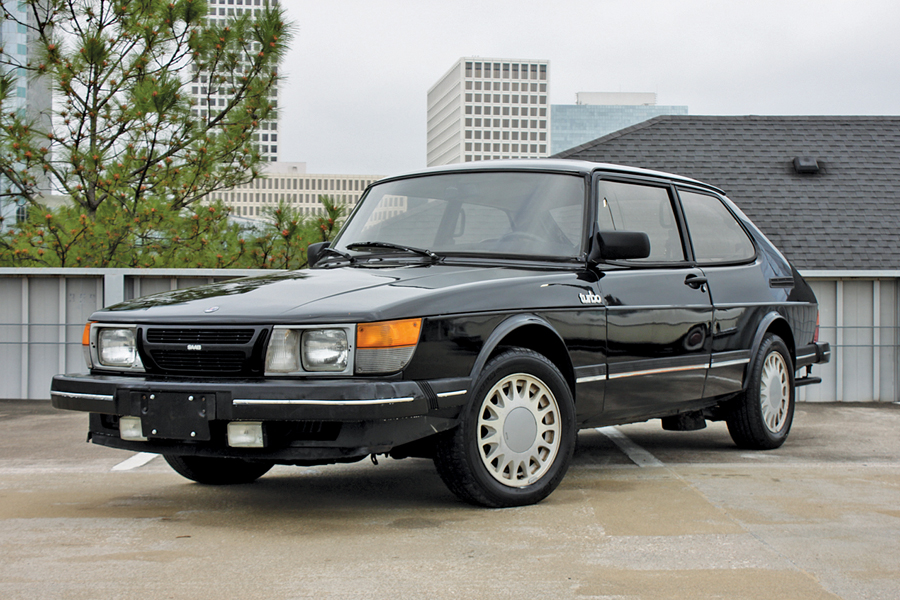
When the Saab 900 Turbo debuted in 1978, it redefined the sports-coupe segment.
If the sporty Swedish hatchback’s shape, spacious interior and funky wheels weren’t enough to force buyers to reconsider the definition of a luxury sports coupe, the 900 Turbo’s engine would.
Under its long, sloping hood, the 900 Turbo hides a longitudinally mounted, turbocharged 4-cylinder engine. That doesn’t seem terribly weird until you realize that it’s cocked over at a 45-degree angle — and backward.
The backward 4-banger sits atop the transaxle. The engine transfers power to the transaxle through a chain. Quirkier still, the top/side of the transaxle forms the engine’s oil pan.
Oddities abound inside the 900 as well. The ignition switch is in the center console — a perfect receptacle for spilled coffee and Coca-Cola. And the 900’s sills were integrated into the door, so as to avoid dirtying your trousers during winter months.
Spool up the Whitesnake
Late-’70s and early-’80s Bimmers were built for cocaine-addled yuppie bankers with lead feet and a taste for oversteer. Saabs of that era were made for unassuming software engineers who told people they listened to Vivaldi but who actually popped in a Whitesnake tape on the way home from work — they liked to get wild, but they didn’t want to project it to the world.
Driving the 900 Turbo is a hoot — so long as you like a good scare now and again. The 2-door hatches handle well enough, thanks to the ample helpings of thick Swedish steel.
The convertibles, which are missing a good portion of that steel, are about as stiff as scrambled eggs.
It can scream like David Coverdale
Keep the 900 Turbo pointed in a straight line and the revs high, and you’ll be bowled over with the power the thing makes. Under the right conditions, 185 horsepower can feel like 900.
Because of the nose-forward engine placement, cornering while accelerating is tricky. Turn the wheel just a bit, and you may find yourself torque- and under-steering off into an embankment — now you feel alive.
Save the Saab 99, there’d never really been a car like the 900 before or since. With the 900 Turbo, Saab knocked Bimmer back on its heels by snatching the thinking man’s sports-luxury-car crown. Today, it knocks collectors off their financial footing with staggering repair costs. Although the 900 Turbo is — on the face of it — an affordable classic, it isn’t really.
Good to be bad
You can pick one up relatively cheaply, sure, anywhere from $3,500 to $9,000. Sorted examples in good nick, though, routinely fetch $20,000 or more. Putting one in your garage isn’t terribly expensive, then. Ensuring it can leave your garage under its own power, however, is a different story.
Now that Saab is essentially dead, having traded hands a few times in the past decade, the parts supply is slim — especially for the pre-GM cars like the first-gen 900 Turbo.
I know full well that I helped exacerbate the problem. In the late aughts, I worked at a Swedish-car repair shop. I was charged with dismantling and scrapping an entire fleet of Saabs, from Sonett IIs to 99s to 900s.
I carelessly ripped apart and trashed more burnt-orange velour and burgundy red leather interiors than I care to count. Without even a whiff of sentimentality, I heaved hundreds of Saab “Soccer Ball,” tri-spoke Aero, and “Inca” aluminum wheels into the bed of our scrap-metal man’s pickup.
Hundreds of engines and transaxles were shown the same disrespect, and suffered the same fate as those funky wheels. I find myself itching with guilt when memories of ’70s Saabs stripped bare, bound for the crusher, flash through my mind.
I realize now just how special Saab 900 Turbos were and are. They’re weird, stylish cars. And I hate that I had a hand in taking some of them off the planet only to be replaced by vehicles that are more appliance than car.
Is this love?
If you can find a well-kept 1978 through 1986 Saab 900 Turbo for a reasonable price, I say get it. Love it and drive it as much as you can. Because when it breaks down — and it will — there’s no telling if you’ll be able to get it going again.
You’re welcome to send me an angry letter when you can’t find spares for it. I deserve it. ♦
As the owner of 6 900 Turbos 85-94, I have to refute some points in your article about these cars. Parts are available, owner community is robust and these cars do not have to be run at high RPM to get the most out of them. My best results have been between 3-4k RPM. Please don’t smear a great marque with fake news!